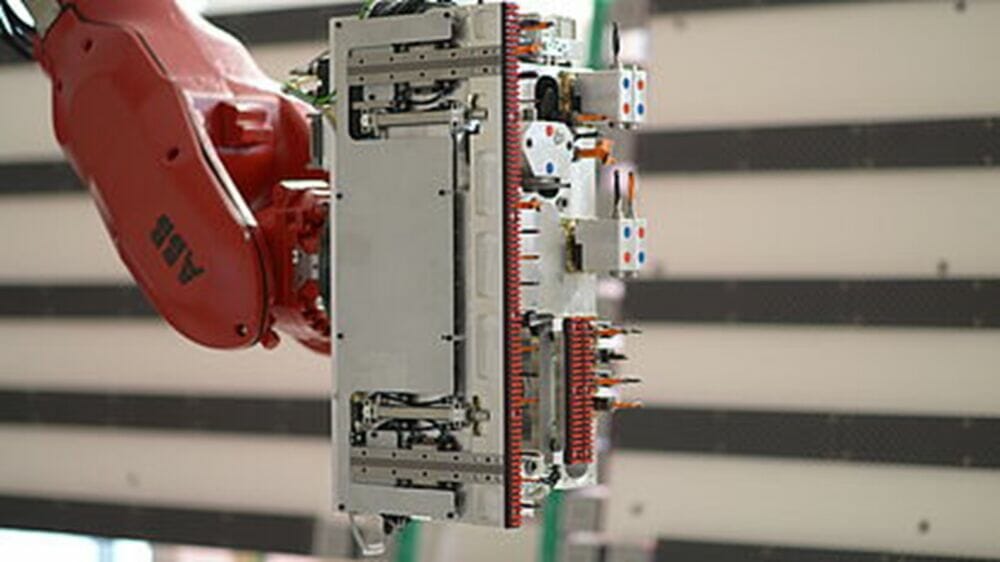The concept of personalisation of products continues to expand, and whether you wish to specify the materials and colour of the interior if your new car, or have your name printed on to a Coke bottle the choice is yours. This trend is also growing within the home as more and more individuals decide that they want something unique.
French kitchen manufacturer Schmidt has risen to the challenge of producing customer specific products using an innovative robotic machining cell for drilling, and assembly of kitchen furniture components. The cell is part of a production line used to manufacture complete kitchen units with a batch size of one.
From component to system supplier
Schmidt is recognised internationally as a quality supplier of kitchen products and has around 1,500 employees worldwide. The company has production facilities in Sélestat, Alsace, in France which is where the robotic machining cell is located. The robot processing cell was designed and built by the Zimmer Group from Rheinau in Germany. Zimmer Group has evolved from being a classic component supplier to become a system provider in their own right and delivered this production system as a turnkey supply. This combination of German perfection and French design guarantee affordable furniture which meets the highest standards.
“Each of the two machining robots carry a multifunction head with 41 tools to perform all necessary woodworking operations without changing tools.”
At the heart of the system are five large ABB robots, connected by a flexible transport system within which the workpieces are clamped and moved, depending upon their size, using four freely programmable shuttles. The design and functionality of this re-circulating shuttle system was recognised with a German Innovation Award in 2019. Operating on a cycle time of less than 2 seconds, furniture components have holes and grooves machined, plus fittings assembled, with all operations performed by the robots. A two-meter-high side panel of a tall cabinet can be immediately followed by a shelf measuring just 15 x 20 centimetres, without any changeover or setup time.
Furniture parts with an accuracy of two tenths of a millimetre
“When we first discussed our plans for such a cell, we were told don’t do it, it can’t be done with sufficient precision using robots,” recalls Managing Director Achim Gauß, who is responsible for technology and sales at Zimmer Group. “At first that was the case. We had to invest a lot in both hardware and software,” Gauß continues. The solution was derived through a compensation algorithm, developed in-house, which uses laser tracking measurement of the robots in the machining area. In addition, the individual furniture parts are clamped into the shuttles by a loading robot and then measured in terms of dimensions and position. This single set-up allows the parts to move along the various processing stations before finally being removed from the shuttles by the unloading robot. This ensures that there is no loss of accuracy due to un-clamping and re-clamping at different stations. A special feature of this robotic solution, for which the Zimmer Group draws from its own pool of grippers and tool changers, among other things, is the drilling operation. This is performed by ABB industrial robots which process the parts with an accuracy of two tenths of a millimetre.
Achim Gauß continues: “Our customer Schmidt wanted a system that had 100% availability, if possible, that is where maintenance requirements did not have to lead to a complete machine shutdown. This is only possible with a modular system. In addition, there was the desire for flexibility, accuracy, future proofing, as well as a batch size of one production without predefined machining programs.” Zimmer Group’s experts solved the availability problem by ensuring easy accessibility to all parts. Individual shuttles can be removed / replaced without the system coming to a complete standstill. In extreme cases, a “simple” exchange of a complete processing robot is also possible.
Performance and flexibility at the highest level
In order to achieve the desired production output, the machining operations are automatically assigned between two machining robots and typical machining operations are combined in one drilling stroke (e.g., hinges, line drilling). To achieve this, each of the machining robots carry a multifunctional head with 41 tools, in order to be able to perform all necessary machining operations without changing tools.
The desire for the greatest possible flexibility was achieved using special software – the so-called optimiser – which generates the machining program from the workpiece description in the customer’s central database when the system is loaded. This direct link between the control system to the higher-level Manufacturing Execution System (MES) achieves full production networking. In addition, Zimmer Group’s HMI provides intuitive operation and extended diagnostic options for the entire robot machining cell.
Industry 4.0 – full networking of production
“In order to be able to reliably organize such a complex system during the design process, but also later when in operation, you need one hundred percent real-time simulation,” explains Achim Gauß.” Such a digital twin makes the system not only highly flexible but also extremely useful for work preparation and scheduling for the customer. We learned a lot in this project and have been able to transfer this know-how to all our components with the digital twin.” With the help of the digital twin in the HIL system, the cell can be built virtually to be able to check the system performance and functionality even before installation. The Zimmer Group’s robotic machining cell both embraces and implements the principles of Industry 4.0.
Schmidt is delighted with the final result, as the cell offers considerable economic advantages in addition to extremely high system availability. For example, the use of industrial robots instead of traditional machine technology together with the simpler design, results in significantly lower investment costs. The re-circulating shuttles within the innovative transport system can be individually controlled in terms of speed, cycle time and positions, and can either be operated individually or in combination.
Considered over the entire life cycle of the system, the flexible robot concept also offers a high level of investment security, as the modular design enables subsequent expansion and future proofing with new processing modules.








